本节课分成二部分讲解:
一、Spark Streaming on Polling from Flume实战
二、Spark Streaming on Polling from Flume源码
第一部分:
推模式(Flume push SparkStreaming) VS 拉模式(SparkStreaming poll Flume)
采用推模式:推模式的理解就是Flume作为缓存,存有数据。监听对应端口,如果服务可以链接,就将数据push过去。(简单,耦合要低),缺点是SparkStreaming 程序没有启动的话,Flume端会报错,同时会导致Spark Streaming 程序来不及消费的情况。
采用拉模式:拉模式就是自己定义一个sink,SparkStreaming自己去channel里面取数据,根据自身条件去获取数据,稳定性好。
Flume poll 实战:
1.Flume poll 配置
进入http://spark.apache.org/docs/latest/streaming-flume-integration.html官网,下载
spark-streaming-flume-sink_2.10-1.6.0.jar、scala-library-2.10.5.jar、commons-lang3-3.3.2.jar三个包:
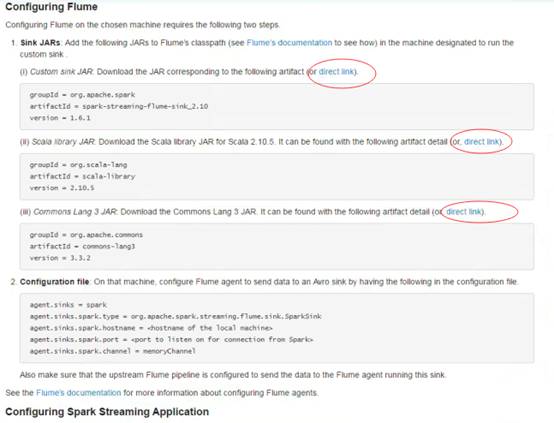
将下载后的三个jar包放入Flume安装lib目录:
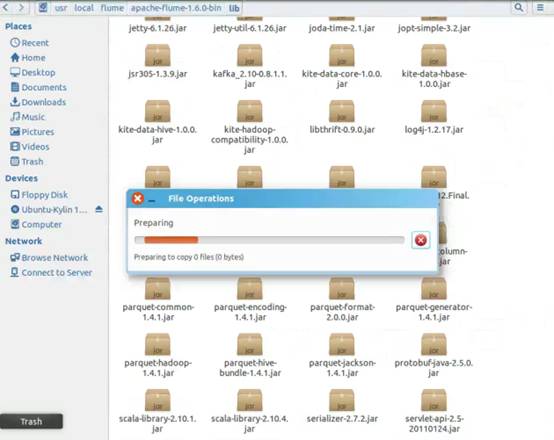
配置Flume conf环境参数:

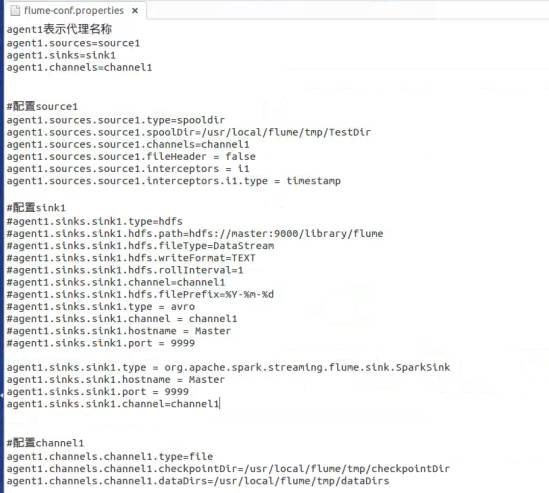
编写业务代码:
public class SparkStreamingPollDataFromFlume {
public static void main(String[] args) {
/*
* 第一步:配置SparkConf:
* 1,至少2条线程:因为Spark Streaming应用程序在运行的时候,至少有一条
* 线程用于不断的循环接收数据,并且至少有一条线程用于处理接受的数据(否则的话无法
* 有线程用于处理数据,随着时间的推移,内存和磁盘都会不堪重负);
* 2,对于集群而言,每个Executor一般肯定不止一个Thread,那对于处理Spark Streaming的
* 应用程序而言,每个Executor一般分配多少Core比较合适?根据我们过去的经验,5个左右的
* Core是最佳的(一个段子分配为奇数个Core表现最佳,例如3个、5个、7个Core等);
*/
SparkConf conf = new SparkConf().setAppName("SparkStreamingPollDataFromFlume").setMaster("local[2]");
/*
* 第二步:创建SparkStreamingContext:
* 1,这个是SparkStreaming应用程序所有功能的起始点和程序调度的核心
* SparkStreamingContext的构建可以基于SparkConf参数,也可基于持久化的SparkStreamingContext的内容
* 来恢复过来(典型的场景是Driver崩溃后重新启动,由于Spark Streaming具有连续7*24小时不间断运行的特征,
* 所有需要在Driver重新启动后继续上衣系的状态,此时的状态恢复需要基于曾经的Checkpoint);
* 2,在一个Spark Streaming应用程序中可以创建若干个SparkStreamingContext对象,使用下一个SparkStreamingContext
* 之前需要把前面正在运行的SparkStreamingContext对象关闭掉,由此,我们获得一个重大的启发SparkStreaming框架也只是
* Spark Core上的一个应用程序而已,只不过Spark Streaming框架箱运行的话需要Spark工程师写业务逻辑处理代码;
*/
JavaStreamingContext jsc = new JavaStreamingContext(conf, Durations.seconds(30));
/*
* 第三步:创建Spark Streaming输入数据来源input Stream:
* 1,数据输入来源可以基于File、HDFS、Flume、Kafka、Socket等
* 2, 在这里我们指定数据来源于网络Socket端口,Spark Streaming连接上该端口并在运行的时候一直监听该端口
* 的数据(当然该端口服务首先必须存在),并且在后续会根据业务需要不断的有数据产生(当然对于Spark Streaming
* 应用程序的运行而言,有无数据其处理流程都是一样的);
* 3,如果经常在每间隔5秒钟没有数据的话不断的启动空的Job其实是会造成调度资源的浪费,因为并没有数据需要发生计算,所以
* 实例的企业级生成环境的代码在具体提交Job前会判断是否有数据,如果没有的话就不再提交Job;
*/
JavaReceiverInputDStream lines = FlumeUtils.createPollingStream(jsc, "Master", 9999);
/*
* 第四步:接下来就像对于RDD编程一样基于DStream进行编程!!!原因是DStream是RDD产生的模板(或者说类),在Spark Streaming具体
* 发生计算前,其实质是把每个Batch的DStream的操作翻译成为对RDD的操作!!!
*对初始的DStream进行Transformation级别的处理,例如map、filter等高阶函数等的编程,来进行具体的数据计算
* 第4.1步:讲每一行的字符串拆分成单个的单词
*/
JavaDStream<String> words = lines.flatMap(new FlatMapFunction<SparkFlumeEvent, String>() { //如果是Scala,由于SAM转换,所以可以写成val words = lines.flatMap { line => line.split(" ")}
@Override
public Iterable<String> call(SparkFlumeEvent event) throws Exception {
String line = new String(event.event().getBody().array());
return Arrays.asList(line.split(" "));
}
});
/*
* 第四步:对初始的DStream进行Transformation级别的处理,例如map、filter等高阶函数等的编程,来进行具体的数据计算
* 第4.2步:在单词拆分的基础上对每个单词实例计数为1,也就是word => (word, 1)
*/
JavaPairDStream<String, Integer> pairs = words.mapToPair(new PairFunction<String, String, Integer>() {
@Override
public Tuple2<String, Integer> call(String word) throws Exception {
return new Tuple2<String, Integer>(word, 1);
}
});
/*
* 第四步:对初始的DStream进行Transformation级别的处理,例如map、filter等高阶函数等的编程,来进行具体的数据计算
* 第4.3步:在每个单词实例计数为1基础之上统计每个单词在文件中出现的总次数
*/
JavaPairDStream<String, Integer> wordsCount = pairs.reduceByKey(new Function2<Integer, Integer, Integer>() { //对相同的Key,进行Value的累计(包括Local和Reducer级别同时Reduce)
@Override
public Integer call(Integer v1, Integer v2) throws Exception {
return v1 + v2;
}
});
/*
* 此处的print并不会直接出发Job的执行,因为现在的一切都是在Spark Streaming框架的控制之下的,对于Spark Streaming
* 而言具体是否触发真正的Job运行是基于设置的Duration时间间隔的
* 诸位一定要注意的是Spark Streaming应用程序要想执行具体的Job,对Dtream就必须有output Stream操作,
* output Stream有很多类型的函数触发,类print、saveAsTextFile、saveAsHadoopFiles等,最为重要的一个
* 方法是foraeachRDD,因为Spark Streaming处理的结果一般都会放在Redis、DB、DashBoard等上面,foreachRDD
* 主要就是用用来完成这些功能的,而且可以随意的自定义具体数据到底放在哪里!!!
*
*/
wordsCount.print();
/*
* Spark Streaming执行引擎也就是Driver开始运行,Driver启动的时候是位于一条新的线程中的,当然其内部有消息循环体,用于
* 接受应用程序本身或者Executor中的消息;
*/
jsc.start();
jsc.awaitTermination();
jsc.close();
}
启动HDFS集群:

启动运行Flume:

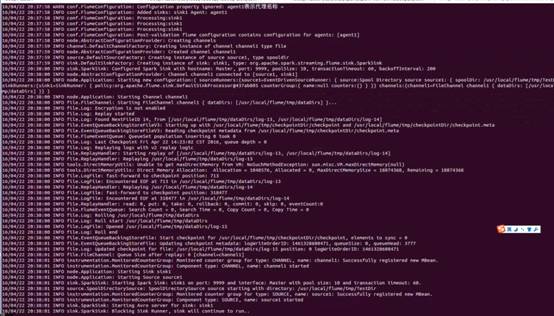
启动eclipse下的应用程序:
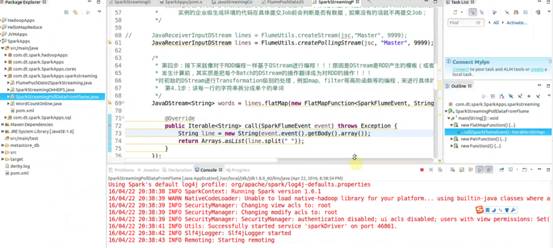
copy测试文件hellospark.txt到Flume flume-conf.properties配置文件中指定的/usr/local/flume/tmp/TestDir目录下:

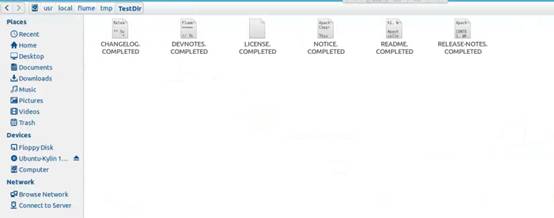
隔30秒后可以在eclipse程序控制台中看到上传的文件单词统计结果。
第二部分:源码分析
1、创建createPollingStream (FlumeUtils.scala )
注意:默认的存储方式是MEMORY_AND_DISK_SER_2
/**
* Creates an input stream that is to be used with the Spark Sink deployed on a Flume agent.
* This stream will poll the sink for data and will pull events as they are available.
* This stream will use a batch size of 1000 events and run 5 threads to pull data.
* @param hostname Address of the host on which the Spark Sink is running
* @param port Port of the host at which the Spark Sink is listening
* @param storageLevel Storage level to use for storing the received objects
*/
def createPollingStream(
ssc: StreamingContext,
hostname: String,
port: Int,
storageLevel: StorageLevel = StorageLevel.MEMORY_AND_DISK_SER_2
): ReceiverInputDStream[SparkFlumeEvent] = {
createPollingStream(ssc, Seq(new InetSocketAddress(hostname, port)), storageLevel)
}
2、参数配置:默认的全局参数,private 级别配置无法修改
private val DEFAULT_POLLING_PARALLELISM = 5
private val DEFAULT_POLLING_BATCH_SIZE = 1000
/**
* Creates an input stream that is to be used with the Spark Sink deployed on a Flume agent.
* This stream will poll the sink for data and will pull events as they are available.
* This stream will use a batch size of 1000 events and run 5 threads to pull data.
* @param addresses List of InetSocketAddresses representing the hosts to connect to.
* @param storageLevel Storage level to use for storing the received objects
*/
def createPollingStream(
ssc: StreamingContext,
addresses: Seq[InetSocketAddress],
storageLevel: StorageLevel
): ReceiverInputDStream[SparkFlumeEvent] = {
createPollingStream(ssc, addresses, storageLevel,
DEFAULT_POLLING_BATCH_SIZE, DEFAULT_POLLING_PARALLELISM)
}
3、创建FlumePollingInputDstream对象
/**
* Creates an input stream that is to be used with the Spark Sink deployed on a Flume agent.
* This stream will poll the sink for data and will pull events as they are available.
* @param addresses List of InetSocketAddresses representing the hosts to connect to.
* @param maxBatchSize Maximum number of events to be pulled from the Spark sink in a
* single RPC call
* @param parallelism Number of concurrent requests this stream should send to the sink. Note
* that having a higher number of requests concurrently being pulled will
* result in this stream using more threads
* @param storageLevel Storage level to use for storing the received objects
*/
def createPollingStream(
ssc: StreamingContext,
addresses: Seq[InetSocketAddress],
storageLevel: StorageLevel,
maxBatchSize: Int,
parallelism: Int
): ReceiverInputDStream[SparkFlumeEvent] = {
new FlumePollingInputDStream[SparkFlumeEvent](ssc, addresses, maxBatchSize,
parallelism, storageLevel)
}
4、继承自ReceiverInputDstream并覆写getReciver方法,调用FlumePollingReciver接口
private[streaming] class FlumePollingInputDStream[T: ClassTag](
_ssc: StreamingContext,
val addresses: Seq[InetSocketAddress],
val maxBatchSize: Int,
val parallelism: Int,
storageLevel: StorageLevel
) extends ReceiverInputDStream[SparkFlumeEvent](_ssc) {
override def getReceiver(): Receiver[SparkFlumeEvent] = {
new FlumePollingReceiver(addresses, maxBatchSize, parallelism, storageLevel)
}
}
5、ReceiverInputDstream 构建了一个线程池,设置为后台线程;并使用lazy和工厂方法创建线程和NioClientSocket(NioClientSocket底层使用NettyServer的方式)
lazy val channelFactoryExecutor =
Executors.newCachedThreadPool(new ThreadFactoryBuilder().setDaemon(true).
setNameFormat("Flume Receiver Channel Thread - %d").build())
lazy val channelFactory =
new NioClientSocketChannelFactory(channelFactoryExecutor, channelFactoryExecutor)
6、receiverExecutor 内部也是线程池;connections是指链接分布式Flume集群的FlumeConnection实体句柄的个数,线程拿到实体句柄访问数据。
lazy val receiverExecutor = Executors.newFixedThreadPool(parallelism,
new ThreadFactoryBuilder().setDaemon(true).setNameFormat("Flume Receiver Thread - %d").build())
private lazy val connections = new LinkedBlockingQueue[FlumeConnection]()
7、启动时创建NettyTransceiver,根据并行度(默认5个)循环提交FlumeBatchFetcher
override def onStart(): Unit = {
// Create the connections to each Flume agent.
addresses.foreach(host => {
val transceiver = new NettyTransceiver(host, channelFactory)
val client = SpecificRequestor.getClient(classOf[SparkFlumeProtocol.Callback], transceiver)
connections.add(new FlumeConnection(transceiver, client))
})
for (i <- 0 until parallelism) {
logInfo("Starting Flume Polling Receiver worker threads..")
// Threads that pull data from Flume.
receiverExecutor.submit(new FlumeBatchFetcher(this))
}
}
8、FlumeBatchFetcher run方法中从Receiver中获取connection链接句柄ack跟消息确认有关
def run(): Unit = {
while (!receiver.isStopped()) {
val connection = receiver.getConnections.poll()
val client = connection.client
var batchReceived = false
var seq: CharSequence = null
try {
getBatch(client) match {
case Some(eventBatch) =>
batchReceived = true
seq = eventBatch.getSequenceNumber
val events = toSparkFlumeEvents(eventBatch.getEvents)
if (store(events)) {
sendAck(client, seq)
} else {
sendNack(batchReceived, client, seq)
}
case None =>
}
} catch {
9、获取一批一批数据方法
/**
* Gets a batch of events from the specified client. This method does not handle any exceptions
* which will be propogated to the caller.
* @param client Client to get events from
* @return [[Some]] which contains the event batch if Flume sent any events back, else [[None]]
*/
private def getBatch(client: SparkFlumeProtocol.Callback): Option[EventBatch] = {
val eventBatch = client.getEventBatch(receiver.getMaxBatchSize)
if (!SparkSinkUtils.isErrorBatch(eventBatch)) {
// No error, proceed with processing data
logDebug(s"Received batch of ${eventBatch.getEvents.size} events with sequence " +
s"number: ${eventBatch.getSequenceNumber}")
Some(eventBatch)
} else {
logWarning("Did not receive events from Flume agent due to error on the Flume agent: " +
eventBatch.getErrorMsg)
None
}
}
总结:
88课
备注:
资料来源于:DT_大数据梦工厂(IMF传奇行动绝密课程)
更多私密内容,请关注微信公众号:DT_Spark